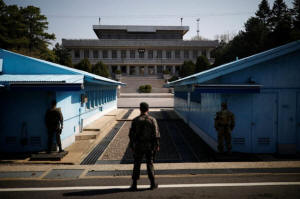|
Person to person: North and South Korea
get neighbourly with direct hot line
 Send a link to a friend
Send a link to a friend
 [April 20, 2018]
By Heekyong Yang and Hyonhee Shin [April 20, 2018]
By Heekyong Yang and Hyonhee Shin
SEOUL (Reuters) - Diplomatic foes North and
South Korea installed a direct phone line between their leaders on
Friday as they prepare for the first summit since 2007 - and the
connection was great, the South's presidential office said.
South Korea's presidential Blue House and North Korea's State Affairs
Commission tested the hot line for four minutes before South Korea's
Moon Jae-in and North Korea's Kim Jong Un talk ahead of next week's
summit, the office said.
"The call quality was very good and we felt like we got a call from our
next-door neighbour," South Korea's director for the Government
Situation Room, Youn Kun-young, told reporters.
Moon will now be able to pick up his office phone to talk to Kim,
instead of communicating through a hot line at the Joint Security Area
in the border village of Panmunjom.
The plan was unveiled by the South's National Security Adviser, Chung
Eui-yong, after he met Kim last month in Pyongyang.

Impoverished North Korea and the rich, democratic South are technically
still at war because their 1950-53 conflict ended in a truce, not a
peace treaty and the North has been engaged in a standoff over its
nuclear and missile programmes that it conducts in defiance of U.N.
Security Council resolutions.
But tensions have eased in recent months, with the North taking part in
the Winter Olympics in the South in February and an exchange of threats
of war with the United States and other bellicose rhetoric evaporating.
Now North and South are meeting next week and Kim and U.S. President
Donald Trump are expected to hold their first ever summit in May or
June, with denuclearisation the topic of the day.
The idea of opening a hot line was hatched in June 2000 when then South
Korean President Kim Dae-jung and the North's Kim Jong Il, the current
leader's father, held the first inter-Korean summit.
[to top of second column]
|

South Korean soldiers stand guard at the truce village of Panmunjom
inside the demilitarized zone (DMZ) separating the two Koreas, South
Korea, April 18, 2018. Picture taken on April 18, 2018. REUTERS/Kim
Hong-Ji

The system reportedly features a telephone, a fax and a screen with
Internet connection for a video chat.
Lim Dong-won, a key architect of the late liberal president's
Sunshine policy of re-engagement with the North, said in his 2007
memoir that the phones played a critical role in resolving sensitive
issues.
The communication channel was also used by Roh Moo-hyun, the
successor to Kim Dae-jung, until the conservative Lee Myung-bak took
over in 2008, Seoul officials said.
There was no communication at Panmunjom as the standoff deepened
over Pyongyang's weapons programmes, until the hot line was used for
the first time in nearly two years in January.
During the lull, South Korean officials would sometimes use a bull
horn to shout messages across the border.
(Additional Reporting by Joyce Lee; Writing by Jane Chung; Editing
by Nick Macfie)
[© 2018 Thomson Reuters. All rights
reserved.]
Copyright 2018 Reuters. All rights reserved. This material may not be published,
broadcast, rewritten or redistributed.
Thompson Reuters is solely responsible for this content.
 |